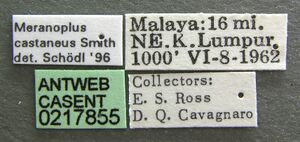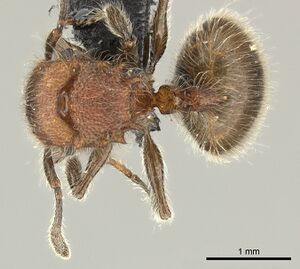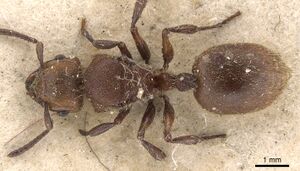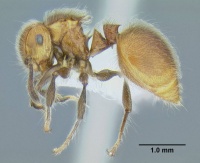Meranoplus castaneus
| Meranoplus castaneus | |
|---|---|

| |
| Scientific classification | |
| Kingdom: | Animalia |
| Phylum: | Arthropoda |
| Class: | Insecta |
| Order: | Hymenoptera |
| Family: | Formicidae |
| Subfamily: | Myrmicinae |
| Tribe: | Crematogastrini |
| Genus: | Meranoplus |
| Species: | M. castaneus |
| Binomial name | |
| Meranoplus castaneus Smith, F., 1857 | |
| Synonyms | |
| |
A few of the paltry number of specimens know for this species are noted as being from rainforest in Sabah. One was collected from the trunk of a tree and another from low vegetation.
Identification
Schödl (1998) - This species may only be mistaken for the related Meranoplus bellii, from which it can readily be separated by the mesonotum posteriorly overhanging the propodeum, in profile by the narrower postpetiole, and by the gastral microreticulation. Furthermore the range of its distribution is different. From all remaining species it is separable by the bidentate petiole.
Keys including this Species
Distribution
Latitudinal Distribution Pattern
Latitudinal Range: 5.016666667° to 2.547988°.
| North Temperate |
North Subtropical |
Tropical | South Subtropical |
South Temperate |
- Source: AntMaps
Distribution based on Regional Taxon Lists
Indo-Australian Region: Borneo (type locality), Brunei Darussalam, Indonesia, Malaysia.
Oriental Region: Thailand.
Distribution based on AntMaps
Distribution based on AntWeb specimens
Check data from AntWeb
Countries Occupied
| Number of countries occupied by this species based on AntWiki Regional Taxon Lists. In general, fewer countries occupied indicates a narrower range, while more countries indicates a more widespread species. |

|
Estimated Abundance
| Relative abundance based on number of AntMaps records per species (this species within the purple bar). Fewer records (to the left) indicates a less abundant/encountered species while more records (to the right) indicates more abundant/encountered species. |

|
Biology
Castes
Worker
Images from AntWeb
           
| |
| Specimen code castaneus. . | |
Queen
Images from AntWeb
   
| |
| Specimen code castaneus. . | |
Nomenclature
The following information is derived from Barry Bolton's Online Catalogue of the Ants of the World.
- castaneus. Meranoplus castaneus Smith, F. 1857a: 81, pl. 2, fig. 7 (q.) BORNEO (East Malaysia: Sarawak).
- Type-material: holotype queen.
- Type-locality: Malaysia: Borneo, Sarawak, “SAR.6” (A.R. Wallace).
- Type-depository: OXUM.
- Forel, 1910a: 29 (w.).
- Status as species: Smith, F. 1858b: 194; Smith, F. 1862d: 412; Roger, 1863b: 39; Mayr, 1863: 428; Smith, F. 1871a: 334; Dalla Torre, 1893: 136; Forel, 1910a: 29; Forel, 1912n: 61; Wheeler, W.M. 1919e: 90; Emery, 1924d: 228; Crawley, 1924: 400; Donisthorpe, 1932c: 451; Chapman & Capco, 1951: 112; Bolton, 1995b: 251; Schödl, 1998: 378 (redescription); Jaitrong & Nabhitabhata, 2005: 27; Pfeiffer, et al. 2011: 47.
- Senior synonym of cordatus: Forel, 1912n: 61; Wheeler, W.M. 1919e: 90; Emery, 1924d: 228; Bolton, 1995b: 251; Schödl, 1998: 378.
- Senior synonym of hammaceros: Schödl, 1998: 378.
- Senior synonym of javanus: Schödl, 1998: 378.
- Distribution: Brunei, Indonesia (Java, Kalimantan, Sumatra), Malaysia (Peninsula, Sabah, Sarawak), Thailand.
- cordatus. Meranoplus cordatus Smith, F. 1857a: 82, pl. 2, fig. 5 (w.) BORNEO (East Malaysia: Sarawak).
- Type-material: holotype worker.
- Type-locality: Malaysia: Borneo, Sarawak, “Sar.3” (A.R. Wallace).
- Type-depository: OXUM.
- Status as species: Smith, F. 1858b: 193; Smith, F. 1862d: 412; Roger, 1863b: 39; Mayr, 1863: 428; Smith, F. 1871a: 334; Mayr, 1872: 155; Emery, 1887b: 470; Dalla Torre, 1893: 136; Donisthorpe, 1932c: 451.
- Junior synonym of castaneus: Forel, 1912n: 61; Wheeler, W.M. 1919e: 90; Emery, 1924d: 228; Bolton, 1995b: 251; Schödl, 1998: 378.
- hammaceros. Meranoplus castaneus subsp. hammaceros Forel, 1912n: 60 (w.) INDONESIA (Sumatra).
- Type-material: lectotype worker (by designation of Schödl, 1998: 378), 3 paralectotype workers.
- Type-locality: lectotype Indonesia: Sumatra, Indrapura (Tritschler); paratypes with same data.
- [Note: other syntype locality: Indonesia: Sumatra (Moesch).]
- Type-depositories: MHNG (lectotype); MHNG, NHMB (paralectotypes).
- Subspecies of castaneus: Emery, 1924d: 228; Chapman & Capco, 1951: 113; Bolton, 1995b: 251.
- Junior synonym of castaneus: Schödl, 1998: 378.
- javanus. Meranoplus bellii subsp. javanus Karavaiev, 1935a: 98, fig. 22 (w.) INDONESIA (Java).
- Type-material: holotype worker.
- Type-locality: Indonesia: Java, Tjiampea, nr Buitenzorg (= Bogor), 2.i.1913, no. 2360 (W. Karawajew).
- Type-depository: SIZK.
- Subspecies of bellii: Chapman & Capco, 1951: 112; Bolton, 1995b: 251.
- Junior synonym of castaneus: Schödl, 1998: 378.
Unless otherwise noted the text for the remainder of this section is reported from the publication that includes the original description.
Description
Worker
Schödl (1998) - TL: 4.5 - 5.1, HL: 0.98 - 1.14, HW: 1.05 - 1 18 CI- 100 - 112 SL: 0.75 - 0.83, SI: 65 - 73, PML: 0.76 - 0.94, PW: 1.03 - 1.2, PMI: 125 - 135 AL- 1 13 - 1.25 (10 measured).
Mandibles striate, armed with five teeth, the basal tooth occasionally reduced to a denticle. Mid-portion of clypeus feebly concave, partly carinulate, anterior margin of clypeus entire. Frontal triangle apparent, glossy, with a faint shagreening. Head above antennal scrobes trapezoid, evenly narrowed towards clypeus; ventral part of head (below antennal scrobes) wider, more rectangular, thus genae distinctly prominent and visible from above. Antennal scrobes shagreened, with longitudinal and transverse carinulae. Genae rugulose. Compound eyes situated well behind middle of lateral sides of head, but not close to posterior corners. Maximum diameter of eye 0.25 - 0.28, with 16-17 ommatidia in the longest row. Promesonotum slightly wider than long, overhanging sides of alitrunk laterally; propodeum overhung by a sinuate, translucent lamella, which is situated between the posterior teeth of the promesonotal shield. Anterior pronotal corners provided with stout anterolaterally projecting teeth. Promesonotal suture sometimes inconspicuously discernible, at its level small, translucent, lateral fenestrae on each side of the shield near or at the lateral margins. Behind the fenestra with a posteriorly directed, stout tooth and one additional arcuate tooth at the posterolateral corner of the mesonotum. Declivity of propodeum glabrous throughout, with occasional longitudinal striae. In about middle of its length propodeum provided with two slender, only little diverging, lateral spines. An arcuate suture between dorsum of alitrunk and propodeum is visible right below the posterior mesonotal margin, when viewed from behind.
Petiole in lateral view tapered, when viewed from behind, distinctly bidentate. Anterior face of petiole glabrous, posterior face with rugae or carinulae. Postpetiole nodiform, in profile with a ventral tooth and one additional acute tooth at the posterior dorsum. First gastral tergite shagreened throughout.
Dorsum of head anteriorly feebly rugulose, posteriorly reticulate-rugulose, width of meshes ca. 25 - 50 jam. Secondarily head covered with distinct shagreening. Promesonotal shield and postpetiole reticulate-rugulose above, shining, without shagrening, width of meshes ca. 25 - 60 μm. Dorsal surface near posterior mesonotal margin rugose! Entire dorsum of individuals covered with dense pubescence of suberect to erect, on head ca. 100 - 150 μm, on alitrunk ca. 150 - 200 μm, on gaster ca. 150 - 250 μm, apically arcuate hairs, and few longer outstanding hairs (ca. 0.3 - 0.4 mm), which distinctly surpass the pubescence.
Colour of body usually of a uniformly greyish brown.
Type Material
Schödl (1998) - Holotype queen (Oxford University Museum of Natural History; examined): "SAR. 6 \ castaneus Sm \ 9 Meranoplus castaneus Smith. TYPE. J.P.L.S.Lond. v.ii,1858,p.42. \ Ann.Mag.Nat.Hist. vol.x,pp. 441-476, 1932. \ Meranoplus castaneus Smith H.St.J.Donisthorpe del. 9.V.1932 9 \ Holotype \ TYPE HYM : 1038 Meranoplus castaneus SMITH HOPE DEPT. OXFORD". Type locality: Sarawak, Borneo, E-Malaysia.
The following notes on F. Smith type specimens have been provided by Barry Bolton (details):
Meranoplus castaneus
Holotype queen in Oxford University Museum of Natural History. Labelled “Sar. 6.”
Meranoplus cordatus
Holotype worker in Oxford University Museum of Natural History. Labelled “Sar. 3.”
References
- Forel, A. 1910a. Glanures myrmécologiques. Ann. Soc. Entomol. Belg. 54: 6-32 (page 29, worker described)
- Forel, A. 1912o. Einige neue und interessante Ameisenformen aus Sumatra etc. Zool. Jahrb. Suppl. 15("Erster Ba Band: 51-78 (page 61, Senior synonym of cordatus)
- Heterick, B.E. 2022. A guide to the ants of Western Australia. Part II: Distribution and biology. Records of the Western Australian Museum, supplement 86: 247-510 (doi:10.18195/issn.0313-122x.86.2022.247-510).
- Khachonpisitsak, S., Yamane, S., Sriwichai, P., Jaitrong, W. 2020. An updated checklist of the ants of Thailand (Hymenoptera, Formicidae). ZooKeys 998, 1–182 (doi:10.3897/zookeys.998.54902).
- Kreider, J.J., Chen, T.W., Hartke, T.R., Buchori, D., Hidayat, P., Nazarreta, R., Scheu, S., Drescher, J. 2021. Rainforest conversion to monocultures favors generalist ants with large colonies. Ecosphere 12 (doi:10.1002/ecs2.3717).
- Radchenko, A.G., Fisher, B.L., Esteves, F.A., Martynova, E.V., Bazhenova, T.N., Lasarenko, S.N. 2023. Ant type specimens (Hymenoptera, Formicidae) in the collection of Volodymyr Opanasovych Karawajew. Communication 1. Dorylinae, Poneromorpha and Pseudomyrmecinae. Zootaxa, 5244(1), 1–32 (doi:10.11646/zootaxa.5244.1.1).
- Schödl, S. 1998. Taxonomic revision of Oriental Meranoplus F. Smith, 1853 (Insecta: Hymenoptera: Formicidae: Myrmicinae). Ann. Naturhist. Mus. Wien. B. Bot. Zool. 100: 361-394 (page 378, Senior synonym of hammaceros and javanus)
- Smith, F. 1857a. Catalogue of the hymenopterous insects collected at Sarawak, Borneo; Mount Ophir, Malacca; and at Singapore, by A. R. Wallace. [part]. J. Proc. Linn. Soc. Lond. Zool. 2: 42-88 (page 81, pl. 2, fig. 7 queen described)
- Yodprasit, K., Buddhakala, N., Tasen, W., Jaitrong, W. 2024. Two new species and a new record of the ant genus Meranoplus Smith, 1853 (Hymenoptera, Formicidae, Myrmicinae) from Thailand. ZooKeys 1210, 207–227 (doi:10.3897/zookeys.1210.125990).
References based on Global Ant Biodiversity Informatics
- Chapman, J. W., and Capco, S. R. 1951. Check list of the ants (Hymenoptera: Formicidae) of Asia. Monogr. Inst. Sci. Technol. Manila 1: 1-327
- Crawley W.C. 1924. Ants from Sumatra, with biological notes by Edward Jacobson. Annals and Magazine of Natural History (9)13: 380-409
- Davidson D. W., S. C. Cook, R. R. Snelling and T. H. Chua. 2003. Explaining the Abundance of Ants in Lowland Tropical Rainforest Canopies. Science 300: 969-972.
- Emery C. 1887. Catalogo delle formiche esistenti nelle collezioni del Museo Civico di Genova. Parte terza. Formiche della regione Indo-Malese e dell'Australia (continuazione e fine). [concl.]. Ann. Mus. Civ. Stor. Nat. 25(5): 427-473.
- Emery, C.. "Catalogo delle formiche esistenti nelle collezioni del Museo Civico di Genova. Parte terza. Formiche della regione Indo-Malese e dell'Australia (continuazione e fine)." Annali del Museo Civico di Storia Naturale Giacomo Doria (Genova) (2) 5, no. 25 (1887): 427-473.
- Forel A. 1910. Glanures myrmécologiques. Ann. Soc. Entomol. Belg. 54: 6-32.
- Forel A. 1912. Einige neue und interessante Ameisenformen aus Sumatra etc. Zool. Jahrb. Suppl. 15: 51-78.
- Hashimoto Y., Y. Morimoto, and M. Mohamed. 2003. Species List of Ground and Leaf Litter Ants Collected in Lower Kinabatangan. Pp 13-18. In Lower Kinabatangan Scientific Expedition 2002, 176 pp. ISBN-13: 983-2369-11-8
- Itino T., and S. Yamane. The vertical distribution of ants on canopy trees in a Bornean lowland rainf forest. Tropics 4(2/3): 277-281.
- Jaitrong W., and T. Ting-Nga. 2005. Ant fauna of Peninsular Botanical Garden (Khao Chong), Trang Province, Southern Thailand (Hymenoptera: Formicidae). The Thailand Natural History Museum Journal 1(2): 137-147.
- Jaitrong W.; Nabhitabhata, J. 2005. A list of known ant species of Thailand. The Thailand Natural History Museum Journal 1(1): 9-54.
- Karavaiev V. 1935. Neue Ameisen aus dem Indo-Australischen Gebiet, nebst Revision einiger Formen. Treubia 15: 57-118.
- Katayama M., K. Kishimoto-Yamada, H. O. Tanaka, T. Endo, Y. Hashimoto, Sk. Yamane, and T. Itioka. 2015. Negative correlation between ant and spider abundances in the canopy of a Bornean tropical rain forest. Biotropica (in press).
- Pfeiffer M.; Mezger, D.; Hosoishi, S.; Bakhtiar, E. Y.; Kohout, R. J. 2011. The Formicidae of Borneo (Insecta: Hymenoptera): a preliminary species list. Asian Myrmecology 4:9-58
- Schödl S. 1998. Taxonomic revision of Oriental Meranoplus F. Smith, 1853 (Insecta: Hymenoptera: Formicidae: Myrmicinae). Annalen des Naturhistorischen Museums in Wien. B, Botanik, Zoologie 100: 361-394.
- Smith, F.. "Catalogue of the hymenopterous insects collected at Sarawak, Borneo; Mount Ophir, Malacca; and at Singapore, by A. R. Wallace." Journal of the Proceedings of the Linnean Society of London, Zoology 2 (1857): 42-88.
- Tanaka H. O., S. Yamane, and T. Itioka. 2012. Effects of a fern-dwelling ant species, Crematogaster difformis, on the ant assemblages of emergent trees in a Bornean tropical rainforest. Ann. Entomol. Soc. Am. 105(4): 592-598.
- Wheeler W. M. 1919. The ants of Borneo. Bulletin of the Museum of Comparative Zoology 63:43-147.
- Yamane S., T. Itino, and A.R. Nona. 1996. Ground ant fauna in a Bornean dipterocarp forest. Raffles Bulletin of Zoology 44(1): 253-262.
- Yusah K. M., T. M. Fayle, G. Harris, and W. A. Foster. 2012. Optimizing diversity assesment protocols for high canopy ants in tropical rain forest. Biotropica 44(1): 73-81.


